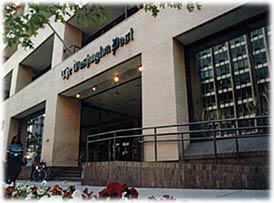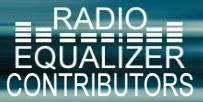Bonneville- Washington Post Deal Announced
MSM FIGHTING BACK?
"Washington Post Radio" Set To Debut On AM Dial
Try placing a year on this scenario: a crusty, old-line newspaper teams up with an equally risk-averse broadcasting outfit, to provide a full time outlet for reporters to discuss their stories on the AM radio dial.
to discuss their stories on the AM radio dial.
What era do you think we'd be talking about here, the fifties? At best, the sixties?
How about 2006!
Yes, the Washington Post, notorious print media fossil, has teamed up with Bonneville Broadcasting to provide "Washington Post Radio" on 1500 AM, until now home to WTOP-AM news radio. Secondarily, its programming will also be heard on 107.7 FM, with its very limited signal reach.
Is this a case of the mainstream media (MSM) fighting back against the new guys? In the swing era, it might very well have worked.
Sure enough, a similar pairing did exist in the fifties, according to the AP:

At the center of Bonneville's significant reworking of its Beltway-area radio holdings, the Post station will feature reporters, editors and columnists discussing their written work. From their press release:
 These moves are so strange, as well as out of touch with today's media realities, it's hard to know where to begin picking them apart.
These moves are so strange, as well as out of touch with today's media realities, it's hard to know where to begin picking them apart.
On the positive side,`WTOP news radio finds a new home on the FM dial, at 103.5. That increases signal coverage for the metro region and places it on a band where it's more likely to be heard by listeners between 25 and 54 years old. That's the age group sought by most major advertisers.
Unfortunately, that's where common sense ends and the Twilight Zone begins, via the Post itself:

Did anyone at Bonneville actually consider what newspaper reporters, columnists and editors sound like on the radio? Most are awful, only a few may be airworthy.
And why should it be any other way? They spend their time writing, not speaking into a microphone.
In addition, because they'll still have deadlines to make, columns to write and sources to contact, one would imagine radio would be a distant second in terms of newsroom priorities. That leads to unfocused, rushed interviews.
Also odd: since Bonneville is owned by the LDS church, the Radio Equalizer has long wondered about the oddly liberal tilt in some of its radio programming. How do Mormons and leftists fit together? Talk about strange bedfellows.
One could say it's about revenue and ratings, but "WaPo Radio" isn't likely to provide much of either one. What it is generating is mainstream media fawning, all over the world.
And would it really increase newspaper readership? Why buy the print version, when you can have it read to you on the air? How much thought was put into this half-baked scheme?
According to the Salt Lake Tribune, company officials (with a straight face) believe there will be national interest in Washington Post radio programming:
Why the desire to compete with NPR? It has very dedicated liberal fans, not likely to switch to commercial radio without some especially compelling reasons to do so.
If this truly does represent the old guard mainstream media's last attempt at fighting back, I truly feel sorry for them. What a sad, painful decline.
More coverage at DCRTV.
The Larsonian is also dumbfounded by the news.
Your Amazon orders that begin with clicks here, regardless of your ultimate purchases, help to support this site's efforts. Thanks again!
"Washington Post Radio" Set To Debut On AM Dial
Try placing a year on this scenario: a crusty, old-line newspaper teams up with an equally risk-averse broadcasting outfit, to provide a full time outlet for reporters
 to discuss their stories on the AM radio dial.
to discuss their stories on the AM radio dial.What era do you think we'd be talking about here, the fifties? At best, the sixties?
How about 2006!
Yes, the Washington Post, notorious print media fossil, has teamed up with Bonneville Broadcasting to provide "Washington Post Radio" on 1500 AM, until now home to WTOP-AM news radio. Secondarily, its programming will also be heard on 107.7 FM, with its very limited signal reach.
Is this a case of the mainstream media (MSM) fighting back against the new guys? In the swing era, it might very well have worked.
Sure enough, a similar pairing did exist in the fifties, according to the AP:

This is not the first time WTOP and The Washington Post have been linked. The Post bought a partial interest in the station from CBS in 1949, then purchased the rest in 1954 and began the all-news format in 1969.
The Post sold WTOP in 1978. Two owners later, Bonneville bought it in 1997.
At the center of Bonneville's significant reworking of its Beltway-area radio holdings, the Post station will feature reporters, editors and columnists discussing their written work. From their press release:
Washington Post Radio will reach listeners in the region with broadcasts featuring Washington Post journalism presented in a new format.
Bonneville International, a diversified media company that owns and
operates the station, invited The Post to work with Bonneville to develop content for the new station. Broadcasting on 107.7 FM and 1500 AM, Washington Post Radio will occupy the location on the radio dial currently used by WTOP, a 24-hour news station owned by Bonneville. Bonneville will move WTOP to 103.5 FM. Bonneville will also air on the station some programming from other sources.
"This is a wonderful opportunity for The Washington Post to encourage the radio audience to read more of the newspaper," said Boisfeuillet Jones Jr., Publisher of The Washington Post.
Washington Post Radio will draw on content from The Washington Post, and it will feature The Post's editors, reporters and columnists providing context on their reporting. The new station will reflect the depth and breadth of Washington Post journalism.
It will present news, information and diverse views concerning national, international and Washington metro area news, including business, entertainment, sports, cultural and consumer news. The station will also broadcast news and commentary from journalists and others outside The Post. Tina Gulland, Director of Television and Radio Projects, will coordinate The Post's coverage for the station with Bonneville.
 These moves are so strange, as well as out of touch with today's media realities, it's hard to know where to begin picking them apart.
These moves are so strange, as well as out of touch with today's media realities, it's hard to know where to begin picking them apart.On the positive side,`WTOP news radio finds a new home on the FM dial, at 103.5. That increases signal coverage for the metro region and places it on a band where it's more likely to be heard by listeners between 25 and 54 years old. That's the age group sought by most major advertisers.
Unfortunately, that's where common sense ends and the Twilight Zone begins, via the Post itself:

The moves involve three local stations that occupy six slices of the AM and FM bands. By reshuffling its station lineup, Bonneville is attempting to place its most popular and lucrative programming -- news -- on the frequencies that have the strongest broadcast signals. At the same time, it essentially is backing out of the music field, eliminating airplay of contemporary recordings and consigning classical to one of its weakest signals.
With only a perfunctory on-air announcement, the Utah-based broadcasting giant at noon yesterday triggered the local radio version of musical chairs. It abruptly knocked WGMS off of 103.5 FM and moved WTOP into that slot. WGMS, in turn, moved to 104.1 and 103.9 -- the former homes of the pop station Z-104, which immediately disappeared. In a flash Z-104's listeners went from hearing upbeat deejays and adult-contemporary singles to a dulcet-toned announcer introducing a Rachmaninoff piano concerto.
Did anyone at Bonneville actually consider what newspaper reporters, columnists and editors sound like on the radio? Most are awful, only a few may be airworthy.
And why should it be any other way? They spend their time writing, not speaking into a microphone.
In addition, because they'll still have deadlines to make, columns to write and sources to contact, one would imagine radio would be a distant second in terms of newsroom priorities. That leads to unfocused, rushed interviews.
Also odd: since Bonneville is owned by the LDS church, the Radio Equalizer has long wondered about the oddly liberal tilt in some of its radio programming. How do Mormons and leftists fit together? Talk about strange bedfellows.
One could say it's about revenue and ratings, but "WaPo Radio" isn't likely to provide much of either one. What it is generating is mainstream media fawning, all over the world.
And would it really increase newspaper readership? Why buy the print version, when you can have it read to you on the air? How much thought was put into this half-baked scheme?
According to the Salt Lake Tribune, company officials (with a straight face) believe there will be national interest in Washington Post radio programming:
It's also possible that Bonneville will broadcast the Post programming in other parts of the country, including Salt Lake City, Johnson said.
"We view this programming to be National Public Radio-like, and perhaps NPR with more energy. Just as NPR programming finds a home in lots of communities in America, perhaps this will, too."
Why the desire to compete with NPR? It has very dedicated liberal fans, not likely to switch to commercial radio without some especially compelling reasons to do so.
If this truly does represent the old guard mainstream media's last attempt at fighting back, I truly feel sorry for them. What a sad, painful decline.
More coverage at DCRTV.
The Larsonian is also dumbfounded by the news.
Your Amazon orders that begin with clicks here, regardless of your ultimate purchases, help to support this site's efforts. Thanks again!



2 Comments:
The Post owned WTOP from the late 40s to the late 70s. Not sure why they sold.
By eLarson, at 05 January, 2006 15:49
eLarson, at 05 January, 2006 15:49
There's also Channel 9 in DC, at one point WTOP-TV. In fact I think that station has had the most call sign changes of any DC station
At first they were WOIC, then came WTOP until about 1978 when it became WDVM (District, Virginia, Maryland).
In 1986, 9 was sold to Gannett and became W*USA. The logo has been noted for having a star between the "W" and the "U". Now there's the CBS eye on the current logo.
Throughout the 70's, 80's and into the 90's, DC's Channel 9 was THE news station with legends like Gordon Peterson and the late Max Robinson. The latter went to ABC News and teamed up with Frank Reynolds for World News Tonight.
By the way, Peterson works now at WJLA-TV, an Allbritton-owned station that speaking of logos has the famed circle 7 logo--even though ABC doesn't own the station. It does own three radio stations including WMAL.
I think WTOP 1500 may have been offered a bigger deal by CBS--perhaps that's why the Post sold.
But the Post was having a say in a couple of other TV stations namely WPLG in Miami, named for the late husband of Post founder Katherine Graham, and WFSB Hartford, named for Frank S Beebe, a Post-Newsweek publisher.
Only WPLG and Orlando's WKMG--named for Katherine Graham herself--are under the Post-Newsweek banner. WFSB was sold in 1997 to Meredith.
By The Real Bob Anthony, at 05 January, 2006 23:27
The Real Bob Anthony, at 05 January, 2006 23:27
Post a Comment
<< Home